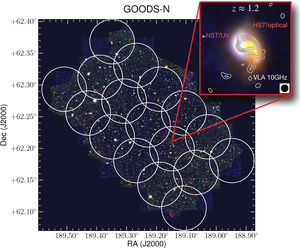The VLA 10GHz Survey of GOODS-N
The VLA 10GHz Survey of GOODS-N

The Team
- PI: Eric Murphy (NRAO)
- Eric Faustino Jiménez-Andrade (UNAM)
- Emmanuel Momjian (NRAO)
- Ranga-Ram Chary (Caltech)
- Chris Carilli (NRAO)
- James Condon (NRAO)
- Mark Dickinson (NOAO)
- Russ Taylor (IDIA)
Synopsis
The VLA 10GHz Survey of GOODS-N is the first high-resolution (0.22 arcsec), high-frequency observational campaign to fully map an extragalactic deep field. The overarching goal of this VLA Large Program is to better trace the star formation history of the Universe. Surveying the extragalactic sky at 10GHz has the advantage of yielding higher angular resolution imaging while probing thermal (free-free) radiation of high-redshift galaxies, which is more directly proportional to the rate of massive star formation. The deep 10GHz images of GOODS-N are well matched to the resolution of existing HST/ACS optical and HST/WFC3-IR (continuum + Hα imaging) data from GOODS and CANDELS, and provide an extinction-free view for the morphologies of dusty star-bursting galaxies that dominate the star formation activity over $1<z<3$.
Our pilot survey consists of 35 hours of VLA observations in A and C configuration taken during 2014-2015, covering a single VLA primary beam (FWHM=4.25 arcmin) and reaching a 0.572 μJy/beam depth and 0.22 arcsec resolution (Murphy et al. 2017). 32 sources are reliably detected, have an optical/infrared counterpart, and have a median redshift of $<z> = 1.24$. The entire GOODS-N field was observed at 10GHz with the VLA in A, B, and C configuration during 2016-2018 using a 17-pointing mosaic pattern. With a total observing time of 360 hours, we reach a 0.22 arcsec resolution and rms noise of 645 nJy/beam across the ~200 square arcmin of the GOODS-N field.
The data products from the entire VLA 10GHz Survey of GOODS-N are already available upon request (see Data).
Acknowledgements
Based on observations taken with the Very Large Array operated by the NRAO. The National Radio Astronomy Observatory is a facility of the National Science Foundation operated under cooperative agreement by Associated Universities, Inc.




Connect with NRAO